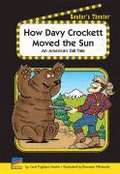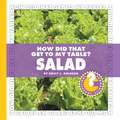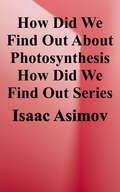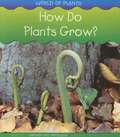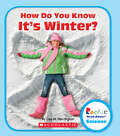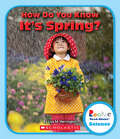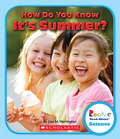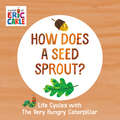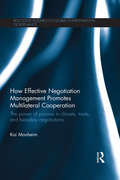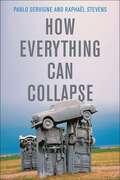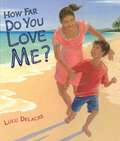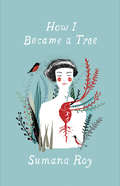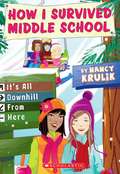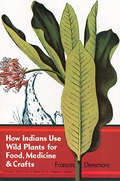- Table View
- List View
How Davy Crockett Moved the Sun: An American Tall Tale
by Carol Pugliano-Martin Jeffrey Fuerst Dewayne WhitesidePerform this American tall tale about how Davy Crockett moved the sun.
How Deep Is the Ocean? (Let's-Read-and-Find-Out Science 2)
by Kathleen Weidner ZoehfeldRead and find out about the deepest part of the ocean in this colorfully illustrated nonfiction picture book.The ocean covers almost three-quarters of the Earth, but how deep does it go? Put on your scuba gear and explore the ocean, from its shallowest waters to its deepest, most mysterious parts. As you dive deeper, you’ll discover glowing animals, strange creatures that don’t need sunlight to survive, and even the largest hunter in the world.With beautiful illustrations and engaging text, How Deep Is the Ocean? will guide young readers into the deepest parts of the ocean. Featuring a find-out-more section with a water-pressure experiment, a lesson in making a sounding line to learn how scientists measure the depth of the ocean, a glossary of new terms, and web research prompts, this book will begin children’s explorations of the deep sea. Both the text and the artwork were vetted for accuracy by Dr. David Gruber, real-life deep sea explorer and professor of biology and environmental science at Baruch College.This is a clear and appealing science book for early elementary age kids, both at home and in the classroom. It's a Level 2 Let's-Read-and-Find-Out, which means the book explores more challenging concepts for children in the primary grades. The 100+ titles in this leading nonfiction series are:hands-on and visualacclaimed and trustedgreat for classroomsTop 10 reasons to love LRFOs:Entertain and educate at the same timeHave appealing, child-centered topicsDevelopmentally appropriate for emerging readersFocused; answering questions instead of using survey approachEmploy engaging picture book quality illustrationsUse simple charts and graphics to improve visual literacy skillsFeature hands-on activities to engage young scientistsMeet national science education standardsWritten/illustrated by award-winning authors/illustrators & vetted by an expert in the fieldOver 130 titles in print, meeting a wide range of kids' scientific interestsBooks in this series support the Common Core Learning Standards, Next Generation Science Standards, and the Science, Technology, Engineering, and Math (STEM) standards. Let's-Read-and-Find-Out is the winner of the American Association for the Advancement of Science/Subaru Science Books & Films Prize for Outstanding Science Series.
How Did Humans Go Extinct?
by Paul Hoppe Johnny MarcianoLet’s learn about the most mystifying species to ever walk the Earth!“A clever . . . way to bring awareness to the very real threats to humanity posed by war, climate change, and capitalism. A compelling and unique dystopian sci-fi picture book for early school age readers, this is recommended for all collections.” —School Library JournalPlib is like every other Nøørfbløøk kid on Earth, except for one thing.He loves humans—those horrible, terrifying monsters who dominated the planet ten million years ago.Only one thing about the humans bothers Plib. What happened to them all? Did they turn the planet into an uninhabitable wasteland? Or did they turn on each other? Or did the humans die out because of something else they did—or didn’t—do?Find the answer in How Did Humans Go Extinct?
How Did I Get Here?: Your Story from the Big Bang to Your Birthday
by Philip BuntingFrom the Big Bang to your birthday, and (almost) everything in between, this funny and informative book tells your story.You are one of the newest members of a family tree that goes way, way, way back to the very first life on Earth. A lot of incredible things had to happen between the beginning of the universe and today in order to make you. The fact that you (and everyone you know) are here is nothing short of mind-boggling! Read this book to discover how it happened, and prepare to be amazed by the awesomeness of you.This clever, funny, and scientific timeline of the journey of human existence is designed to get young readers asking questions, finding answers, and marveling at the many wonders of our world, from the Big Bang, to evolution, to a brand-new baby, and more.
How Did That Get to My Table? Salad (Community Connections)
by Emily J. DolbearYoung readers will gain an understanding on how salad is grown and how it ends up on their table. Picture descriptions added.
How Did We Find Out About Photosynthesis? (How Did We Find Out About…)
by Isaac AsimovTraces the scientific discoveries that led to our understanding of photosynthesis and how this process relates to the food supply, changing ecological balance, and threats to the Earth's atmosphere.
How Do Apples Grow (Lets read-and-find-out Science #Stage 2)
by Betsy MaestroDescribes the life cycle of an apple from its initial appearance as a spring bud to that point in time when it becomes a fully ripe fruit.
How Do Plants Grow? (World Of Plants Ser.)
by Louise Spilsbury Richard SpilsburyLooking inside a seed. We'll look at a cut-open bean seed and talk about the food store and the baby plant and the seed coat. The baby plant in a seed stays safe and warm inside the seed coat until it is ready to start growing, usually in spring when the weather is warm and wet.
How Do You Know It's Fall? (Rookie Read-About Science: Seasons)
by Lisa M. HerringtonHow do you know its fall?Through vivid photos and engaging nonfiction text, this fun and fact-filled Rookie Read-About Science book answers the question, How do you know its fall? Covering everything from weather patterns to animal behaviors to seasonal activities, How Do You Know Its Fall? gives readers (Ages 6-7) an in-depth look at this season of change.
How Do You Know It's Spring?
by Allan FowlerHow do you know it's spring? When leaves begin to grow on the trees... when the grass turns green again... when the first flowers bloom in your garden or in the park, then you know it's springtime!
How Do You Know It's Winter (Rookie Read-About Science: Seasons)
by Lisa M. HerringtonHow Do You Know It's Winter?Through vivid photos and engaging nonfiction text, this fun and fact-filled Rookie Read-About Science book answers the question, How do you know its winter? Covering everything from weather patterns to animal behaviors to seasonal activities, How Do You Know Its Winter? gives readers (Ages 6-7) an in-depth look at this snowy season.
How Do You Know It's Winter? (Into Reading, Read Aloud Module 5 #2)
by Ruth OwenNIMAC-sourced textbook
How Does a Seed Sprout?: Life Cycles with The Very Hungry Caterpillar (The World of Eric Carle)
by Eric CarleLearn how a seed becomes a tree with Eric Carle's classic artwork and The Very Hungry Caterpillar!In this nonfiction story, young readers explore the transformation of a seed into a tree. The miracles of nature come to life in this early-learning series centered around life cycles, featuring simple text and Eric Carle's classic illustrations!
How Does a Tree Help? (Into Reading, Level B)
by David Bauer<p>NIMAC-sourced textbook <p>All kinds of animals make their homes in trees. Children do, too!</p>
How Effective Negotiation Management Promotes Multilateral Cooperation: The power of process in climate, trade, and biosafety negotiations (Routledge Research in Global Environmental Governance)
by Kai MonheimMultilateral negotiations on worldwide challenges have grown in importance with rising global interdependence. Yet, they have recently proven slow to address these challenges successfully. This book discusses the questions which have arisen from the highly varying results of recent multilateral attempts to reach cooperation on some of the critical global challenges of our times. These include the long-awaited UN climate change summit in Copenhagen, which ended without official agreement in 2009; Cancún one year later, attaining at least moderate tangible results; the first salient trade negotiations after the creation of the WTO, which broke down in Seattle in 1999 and were only successfully launched in 2001 in Qatar as the Doha Development Agenda; and the biosafety negotiations to address the international handling of Living Modified Organisms, which first collapsed in 1999, before they reached the Cartagena Protocol in 2000. Using in-depth empirical analysis, the book examines the determinants of success or failure in efforts to form regimes and manage the process of multilateral negotiations. The book draws on data from 62 interviews with organizers and chief climate and trade negotiators to discover what has driven delegations in their final decision on agreement, finding that with negotiation management, organisers hold a powerful tool in their hands to influence multilateral negotiations. This comprehensive negotiation framework, its comparison across regimes and the rich and first-hand empirical material from decision-makers make this invaluable reading for students and scholars of politics, international relations, global environmental governance, climate change and international trade, as well as organizers and delegates of multilateral negotiations. This research has been awarded the German Mediation Scholarship Prize for 2014 by the Center for Mediation in Cologne.
How Everything Can Collapse: A Manual for our Times
by Pablo Servigne Raphael StevensWhat if our civilization were to collapse? Not many centuries into the future, but in our own lifetimes? Most people recognize that we face huge challenges today, from climate change and its potentially catastrophic consequences to a plethora of socio-political problems, but we find it hard to face up to the very real possibility that these crises could produce a collapse of our entire civilization. Yet we now have a great deal of evidence to suggest that we are up against growing systemic instabilities that pose a serious threat to the capacity of human populations to maintain themselves in a sustainable environment. <p><p> In this important book, Pablo Servigne and Raphaël Stevens confront these issues head-on. They examine the scientific evidence and show how its findings, often presented in a detached and abstract way, are connected to people’s ordinary experiences – joining the dots, as it were, between the Anthropocene and our everyday lives. In so doing they provide a valuable guide that will help everyone make sense of the new and potentially catastrophic situation in which we now find ourselves. Today, utopia has changed sides: it is the utopians who believe that everything can continue as before, while realists put their energy into making a transition and building local resilience. Collapse is the horizon of our generation. But collapse is not the end – it’s the beginning of our future. We will reinvent new ways of living in the world and being attentive to ourselves, to other human beings and to all our fellow creatures.
How Far Do You Love Me?
by Lulu Delacre<p>Based on a bedtime game author/illustrator Lulu Delacre played with her young daughters, How Far Do You Love Me? is an “I love you” book with a twist. <p>With every expression of love, readers visit one of thirteen different locations around the world, each a beautifully illustrated scene of adults and children in a place of natural beauty. <p>Guided Reading: K; Lexile: AD650L; Interest Level: Grades PreK - 3; Reading Level: Grades 2 - 3; Themes: Colors, Nature/Science, Multi-ethnic interest, Environment/Nature, Cultural Diversity, Childhood Experiences and Memories, Empathy/Compassion, Gratitude, Optimism/Enthusiasm, Realistic Fiction, Water</p>
How Herbs Healed the World: And Other Stories of Remarkable Plants
by Connor Smith'The writing shines when recounting the stories behind these herbs, offering a blend of history and botanical fascination' - RHS, The GardenHerbs are wonderful things. Without them so much would not be possible. With the advance of science over the last two hundred years these once mystical plants have changed and saved countless lives, vastly improving our standard of living while providing us all with a much richer, healthier diet. Today, we take for granted a world full oflife-saving drugs, luxury cosmetics and exotic foods.This fascinating book will tell this story: revealing how poisons once used by the ancient Romans such as Deadly Nightshade are now being used in modern medicine or how the herbs used by indigenous people around the world have provided remedies for countless illnesses. It will explore the myths and legends behind herbs such as the infamous Mandrake and how herbs such as Yarrow are still being used to treat wounds today, just as they were thousands of years ago; and it will show how exotic herbs from across the globe have enriched our livesand delve into the origins of the culinary herbs that everyone knows and loves.Seventy-five herbs have been carefully chosen to tell the story of how they have each changed our world, looking back at their origins and what was once believed, while comparing this with the modern day uses and the scientific value of these plants enabling the reader to understand and appreciate their importance.Each double page spread will provide both historic and modern illustrations of each herb alongside captivating accounts of their historical and modern day uses including supplementary botanical and horticultural information for each.
How Herbs Healed the World: And Other Stories of Remarkable Plants
by Connor Smith'The writing shines when recounting the stories behind these herbs, offering a blend of history and botanical fascination' - RHS, The GardenHerbs are wonderful things. Without them so much would not be possible. With the advance of science over the last two hundred years these once mystical plants have changed and saved countless lives, vastly improving our standard of living while providing us all with a much richer, healthier diet. Today, we take for granted a world full oflife-saving drugs, luxury cosmetics and exotic foods.This fascinating book will tell this story: revealing how poisons once used by the ancient Romans such as Deadly Nightshade are now being used in modern medicine or how the herbs used by indigenous people around the world have provided remedies for countless illnesses. It will explore the myths and legends behind herbs such as the infamous Mandrake and how herbs such as Yarrow are still being used to treat wounds today, just as they were thousands of years ago; and it will show how exotic herbs from across the globe have enriched our livesand delve into the origins of the culinary herbs that everyone knows and loves.Seventy-five herbs have been carefully chosen to tell the story of how they have each changed our world, looking back at their origins and what was once believed, while comparing this with the modern day uses and the scientific value of these plants enabling the reader to understand and appreciate their importance.Each double page spread will provide both historic and modern illustrations of each herb alongside captivating accounts of their historical and modern day uses including supplementary botanical and horticultural information for each.
How I Became a Tree
by Sumana RoyAn exquisite, lovingly crafted meditation on plants, trees, and our place in the natural world, in the tradition of Robin Wall Kimmerer’s Braiding Sweetgrass and Annie Dillard’s Pilgrim at Tinker Creek. <p><p> I was tired of speed. I wanted to live tree time.” So writes Sumana Roy at the start of How I Became a Tree, her captivating, adventurous, and self-reflective vision of what it means to be human in the natural world. <p><p> Drawn to trees’ wisdom, their nonviolent way of being, their ability to cope with loneliness and pain, Roy movingly explores the lessons that writers, painters, photographers, scientists, and spiritual figures have gleaned through their engagement with trees—from Rabindranath Tagore to Tomas Tranströmer, Ovid to Octavio Paz, William Shakespeare to Margaret Atwood. Her stunning meditations on forests, plant life, time, self, and the exhaustion of being human evoke the spacious, relaxed rhythms of the trees themselves. <p><p> Hailed upon its original publication in India as “a love song to plants and trees” and “an ode to all that is unnoticed, ill, neglected, and yet resilient,” How I Became a Tree blends literary history, theology, philosophy, botany, and more, and ultimately prompts readers to slow down and to imagine a reenchanted world in which humans live more like trees.
How I Survived Middle School #8: It's All Downhill From Here
by Nancy KrulikBestselling author Nancy Krulik delves into the mind of a twelve-year-old trying to survive middle school.<P><P> It's wintertime at Joyce Kilmer Middle School, and everyone is thrilled when school is closed because of a huge snowstorm. Everyone except Jenny, that is! Addie's mom has to work, so Addie's spending the day at Jenny's house. Jenny's stuck hanging out with her former BFF while her friends all go sledding. Thinking about the upcoming school-sponsored ski trip helps get Jenny through the day, but will Addie ruin that for her, too?
How I Survived My Summer Vacation (Camp Haunted Hills #1)
by Bruce CovilleAs soon as Stuart Glassman sees the ad for a summer movie camp, he knows that this is the place for him. What the ad doesn't say is that Camp Haunted Hill is run by Gregory Stevens, the man who makes the world's scariest movies -- and that he plans to try out his special effects on the campers!
How Indians Use Wild Plants for Food, Medicine & Crafts
by Frances Densmore"Learn the natural ways of the Chippewa Indians with this great book from Dover." — Texas Kitchen and Garden and MoreThe uses of plants — for food, for medicine, for arts, crafts, and dyeing — among the Chippewa Indians of Minnesota and Wisconsin show the great extent to which they understood and utilized natural resources. In this book those traditions are captured, providing a wealth of new material for those interested in natural food, natural cures, and native crafts.In separate sections describing the major areas of use, Miss Densmore, an ethnologist with the Smithsonian Institution, details the uses of nearly 200 plants with emphasis on wild plants and lesser-known uses. For those interested in natural foods she gives extensive coverage to the gathering and preparation of maple sugar and wild rice, as well as preparations for beverages from leaves and twigs of common plants, seasonings including mint and bearberry, the methods of preparing wild rice and corn, cultivated and wild vegetables, and wild fruits and berries. On Indian medicines she tells the basic methods of gathering plants and the basic surgical and medical methods. Then she gives a complete list of the plants with their botanical names, uses, parts used, preparation and administration, and other notes and references. Also covered are plants used as charms, plants used in natural dyes, and plants in the useful and decorative arts including uses for household items, toys, mats, twine, baskets, bows, and tools, with special emphasis on the uses of birch bark and cedar. This section will be especially useful for supplying new and unusual craft ideas. In addition, 36 plates show the many stages of plant gathering and preparation and many of the artistic uses. While a number of the plants discussed are native only to the Great Lakes region, many are found throughout a wide range.Those studying the Indians of the Great Lakes region, or those trying to get back to nature through understanding and using natural materials, will find much about the use of plants in all areas of community life. Because of Miss Densmore’s deep knowledge and clear presentation, her study remains a rich and useful source for learning about or using native foods, native cures, and native crafts.
